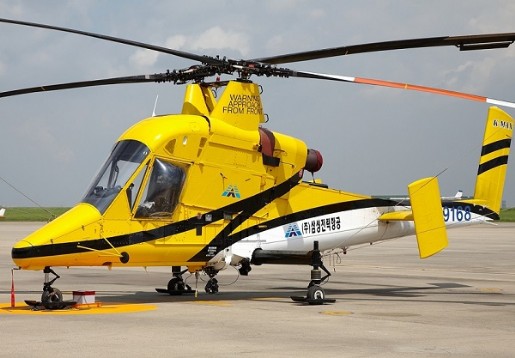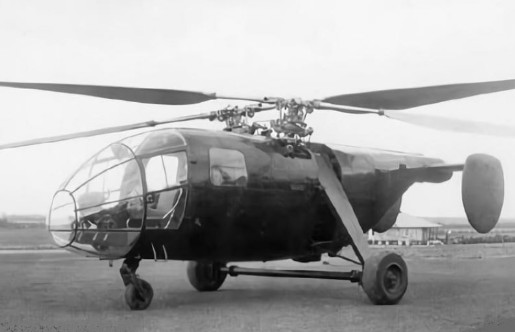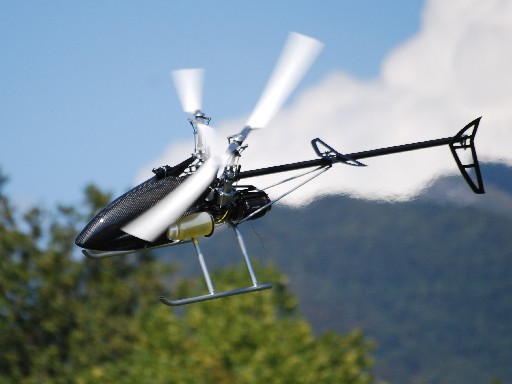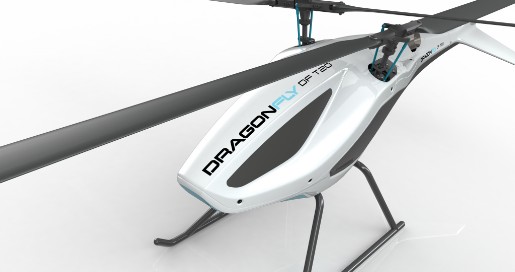News / Projects
At this point, new and innovative projects from "CAD + Modelltechnik Jung" are presented below. These are currently in the design phase, prototyping or already in the test phase.
After successfully completing the tests, these will in future be produced and sold in small series.
If you have any questions about the projects and products presented here, please contact:
We would be happy to provide you with further information or make you an offer.
Do you also have new ideas ... but fail to implement them?! Please contact us. We're here to help!
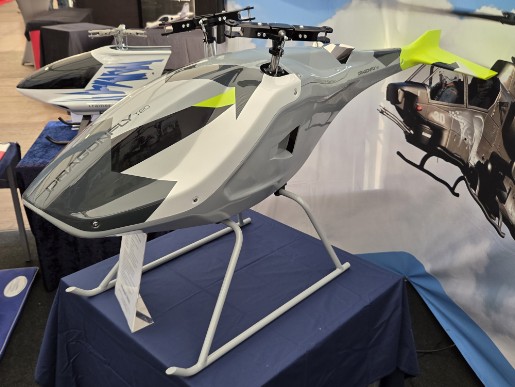
Presentation of the new Flettner Dragonfly T20-RC helicopter at Jetpower 2025 in Breitscheid. More information about the model can be found here.
Our special thanks go to the trade fair organizers, the company Premium-Helicopter and the many interested visitors.
More photos of the Dragonfly T20-RC and many other presented models from the jet and model helicopter categories can be found here.

Jetpower Trade Fair 2025, we are exhibiting!
We are exhibiting at the Alterbaum-Premium-Helicopter stand and presenting the new Dragonfly T20-RC
We look forward to your visit!
For more information about the fair and how to find us, see Link
Kamox Ka-15, scale 1 : 4
As a German-Swiss cooperation project, we are currently working on a 1:4 scale replica of a Kamov Ka-15. The rotor diameter will be just under 2.5 m (converted to scale 2.49 m). The fuselage length is approx. 1.41 m (including the two vertical stabilizers approx. 1.57 m), with a total height of the model of almost 900 mm. The model is powered by the electrified version of our proven coaxial rotor mechanics. The Hacker Q80 is intended as the drive motor. It is operated with 12 S-Lipo batteries. A maximum take-off weight of less than 25 kg should be possible. The prototypical wheel chassis, with the two steerable wheels at the front, is sprung according to the model. The fuselage cell is conventionally manufactured in GRP. If we still find some people interested in the project, a semi-scale version of the two rotor heads with the yaw linkage between the two rotor heads could also be implemented. Otherwise, it remains with the existing yaw linkage of the Ka-52 (i.e. yaw linkage arranged above the upper rotor head). Of course, it is also planned to control the two large rudders and the elevator. A cockpit extension completes the version of the Russian vintage model from 1952. In order to increase the prototypical similarity in terms of drive, it would also be conceivable in the future that the model would be powered by a radial engine similar to the original.
The two coaxial rotor mechanics for the Hacker Q80 are now complete for the first two models. The elaborate, sprung scale landing gears (consisting of the left/right main landing gears and the two nose gears) are also complete. The negative molds for the Ka-15 fuselage are also finished. The first fuselage parts (fiberglass, carbon-reinforced) are currently being manufactured. The vacuum-formed window sets for the model complete the project. Work is currently underway on the scale interior of the cockpit.
You can download a 3-side view of the model being planned with the main dimensions here. The model will be available from middle 2025.
If you would like to find out more about the original Kamov Ka-15, here is a link to the Wikipedia entry.
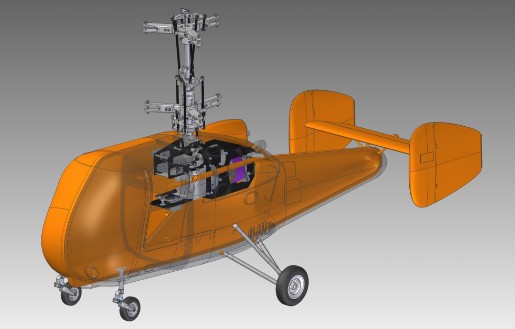
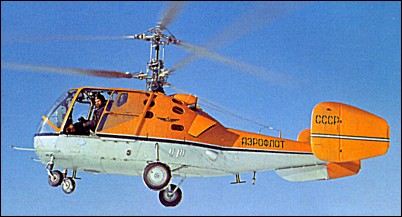
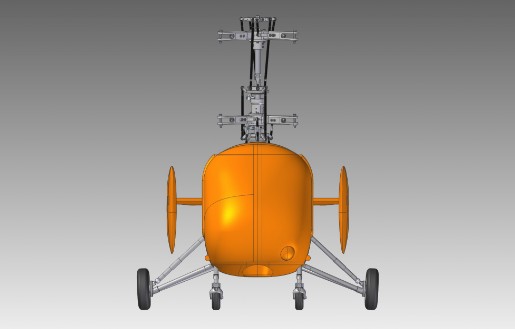
Rotor-Live 2024! - 09 bis 10 März in Iffezheim
This year we were at Rotor Live for the first time and, among other things, the Kaman K-Max 1200 was presented in a scale of 1: 4.4, with a rotor diameter of 3.3 m, in an all-aluminum construction.
Also the K-Max-Trainer Dragon, with a rotor diameter of 2.5 m, which is powered by the new Jakadofksy PRO-7000 turbine.
Many thanks again to the organizers and the operators of the exhibition at Modellflug Kompetenzcenter Schweiz!
The interest in our models on display was truly overwhelming. Many thanks again to everyone who was interested, “old” and new friends we met.
The Kaman K-Max 1200 can be seen in some detail in the photos above. Also the electro-Flettner mechanics for the Abeille NC-2001. And the new Python mechanics, powered by the SPT10-RX-H.
There are also many highlights from other areas of Rotor Live 2024!
Attached is the report in the May 2024 issue of ROTOR magazine about the K-Max 1200.

Calzium bucket, available in different scales
- NEW to the range is a concrete bucket, suitable for scale models that are also originally used for transporting external loads
- The following scales are available: 1:4, 1:5, and 1:6 (other sizes, i.e., other scales, are also available upon request).
- Supplied unpainted and can be customized. To ensure the RP plastic has the smoothest possible surface, the parts must be wet-sanded by the customer and sprayed with filler (e.g., from a spray can, not included).
- A mini servo is required for true-to-scale application of lime or similar in flight. This is located under a cover in the lime container and is controlled via a correspondingly long servo cable. The servo used is the "KST X06H V6.0." If required, we can supply the appropriate KST servo.
- Delivery does not include the rope/cable for the helicopter.
- The prices are based on the fact that the printing time for the plastic parts alone is between 12 and 25 hours (depending on the scale).
- Supplied as an assembly kit (all parts are 3D-printed using filament or made of fiberglass, including small parts).
- Diameter ca. 242 mm
- Height 328 mm (über alles)
- Volume ca. 6,5 Ltr.
- Weight ca. 650 gr.
- Diameter ca. 194 mm
- Height 262 mm
- Volume ca. 3,3 Ltr.
- Weight ca. 450 gr.
- Diameter ca. 161 mm
- Height 219 mm
- Volume ca. 1,9 Ltr.
- Weight ca. 300 gr.
Techn. data:
Scale 1:4
Scale 1:5
Scale 1:6
Helicopter drone Koax X-342, MTOW 150 kg
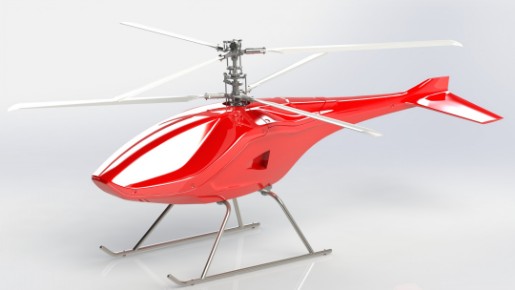
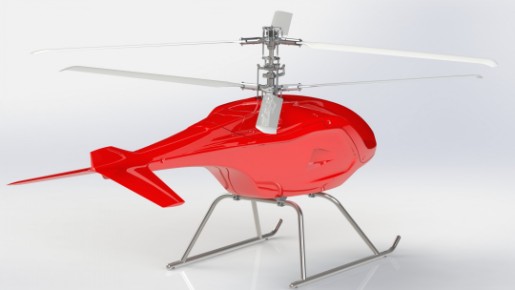
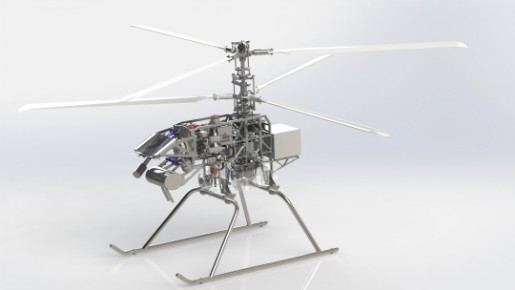
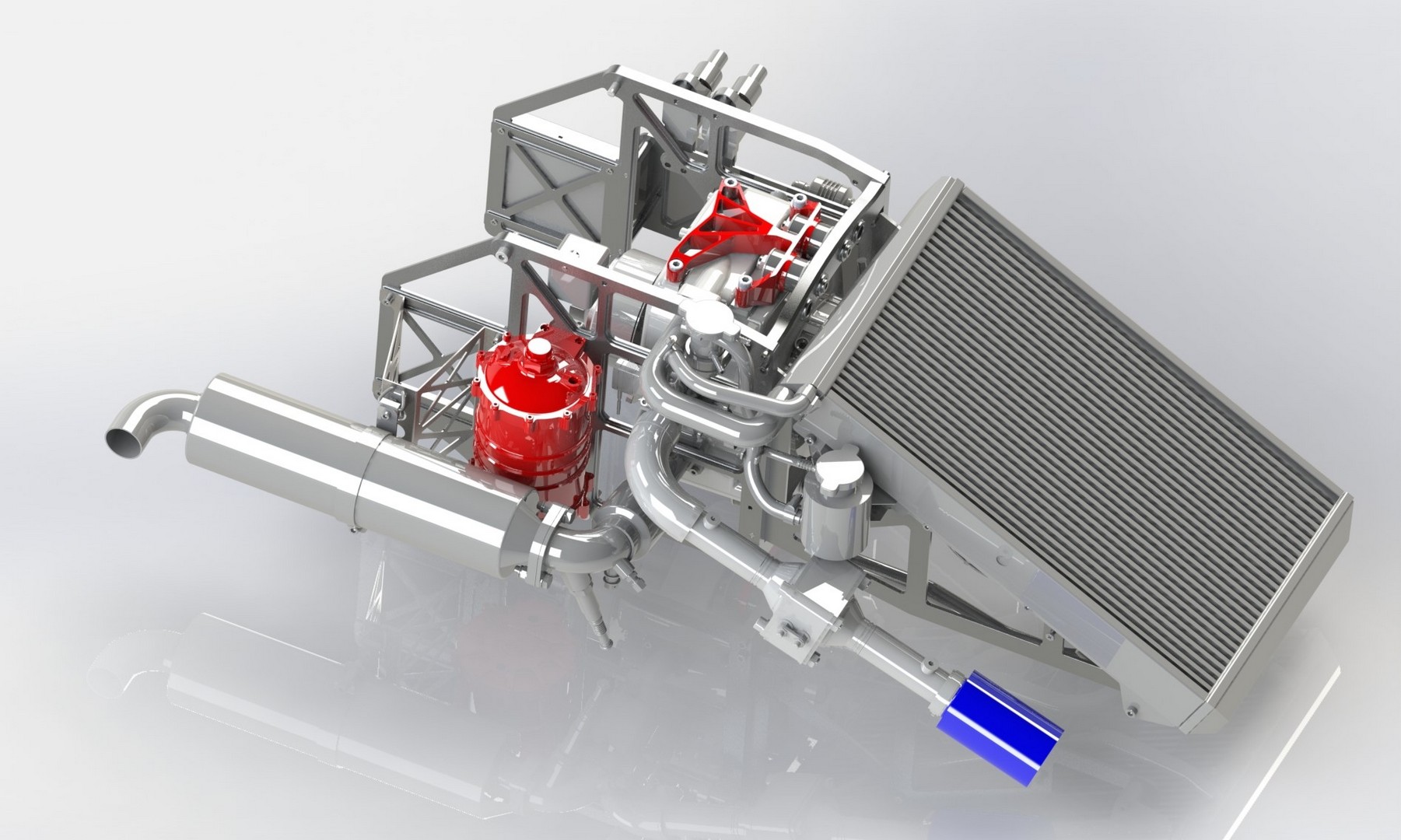
As a completely new design, the Koax X-342 helicopter drone was created in our company in the last few months. A powerful Wankel engine is used as the propulsion engine, which also allows higher flight altitudes. Depending on the model, gasoline or kerosene Jet A-1 can be used.
As a special feature, the entire motor unit is mounted on a separate frame. Using just six screws, the entire motor unit can be changed within a few minutes if necessary.
Another special feature is that both rotor shafts are inserted into the counter-rotation gear using shaft teeth. This also simplifies assembly/disassembly if necessary.
The entire design is granted as a manufacturing license (exclusive license available upon request). Please refer to our offer in the shop for the exact description of the documents. However, we can also supply all CNC-parts and standard parts including the special tank the rotor blades and fuselage. A special design of the fuselage cell is also possible on request.
Technical specifications:
• Coaxial rotor system with 2 x 3 rotor blades, in opposite directions
• Rotor diameter 3.40 m
• Drive by powered by rotary engine with approx. 20 - 30 kW of power (depending on the manufacturer and version)
• Transmission: 2-stage reduction gear, both stages with oil bath
• Robust industrial design, designed for minimal effort for operation and maintenance
• Flight time: with a fuel consumption of approx. 6.5 liters per hour, 4 hours of flight time is possible; with additional tanks, longer flight times are also possible
• Integrated generator for charging the buffer batteries for autopilot and payload. Can also be used as a drive for a safe landing in an emergency (possible on request)
• Motor unit mounted on a separate frame for quick changing if necessary
• The shown Wankel engine is not included in the license. But any other Wankel engine, including integration (e.g. manufacturer Skypower, Aixro, UAV Engines, Austro Engine), as far as possible and sensible
• Pictures show the coaxial rotor mechanics Koax X-342 in the enlarged fuselage cell of the Dragonfly T25 or as a trainer version with canopy
• MTOW: 150 kg (330 lbs)
• Payload and fuel: ca. 75 kg (165 lbs)
• Max. speed: approx. 150 km/h
• Max. flight altitude: 3.500 m N.N.
More information on the exact scope of the manufacturing license is available upon request.
Attached is a data sheet with the main dimensions and a product presentation (PDF).
If you are interested, we would be happy to make you an offer:
Python helicopter turbine mechanics, for JetCat SPT15-RX-H
The Python helicopter turbine mechanics for the JetCat SPT15-RX-H were created as a new design on behalf of a customer. This mechanics can be used wherever large models over 50 kg and the required power are to be driven.
Technical data:
• Rotor shaft diameter 20 mm
• Rotor diameter: up to 3.40 m
• Swashplate linkage with 4 servos
• Drive: JetCat, 2-shaft turbine SPT15-RX-H
• Power transmission: two-stage reduction gear, first stage with 32 mm wide toothed belt, second stage running in an oil bath
• Robust industrial design, designed for minimal effort for operation and maintenance
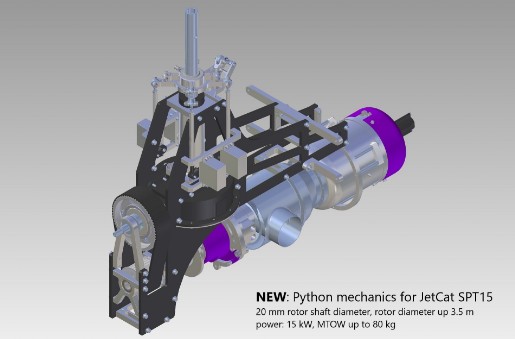
Carbon rotor blades VIPER-C80
New to the range in our shop are carbon rotor blades VIPER-C80 with a blade length of 1,270 mm. These are suitable for model helicopters and helicopter drones with a maximum take-off weight of up to 90 kg (designed with 3 or more rotor blades).
Technical data:
- blade length 1,270 mm
- blade depth 80 mm
- blade grip 22 mm
- bore 6 mm
- material carbon
- top coating white (other colors on request)
- price on request
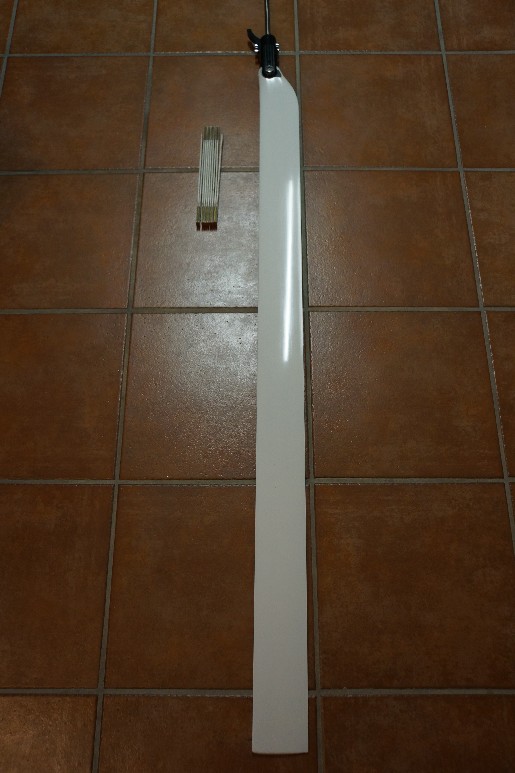
Kaman K-Max 1200, full-aluminum construction
As already announced, the K-Max 1200 in a scale of 1: 4.4 is in the process of being completed and has already successfully completed the first test flights at a heli meeting in Loorholz/Switzerland!
The fuselage cell, manufactured by the Spanish company www.alumodels.com, sold by Klaus Weise (XXL model helicopter), is made entirely of aluminum, i.e. designed exactly like the original. More scale is not possible! The thin aluminum sheets of the entire fuselage cell are riveted to a stable chassis made of stainless steel sheets to form a stable unit.
The 1 : 4.4 scale model has a rotor diameter of 3.3 m (alternatively with 2.8 m and changed speed). The drive is provided by a PJW-Turbine PRO-6000 or electrically by a Hacker Q-80.
Below is a video of one of the first flights of the model and some detailed photos of the level of detail of the model.
The model can be purchased from us as a kit or as a finished model. The complex Flettner turbine mechanics and the scale chassis can also be obtained directly from us.
If you are interested, we will be happy to make you an offer.
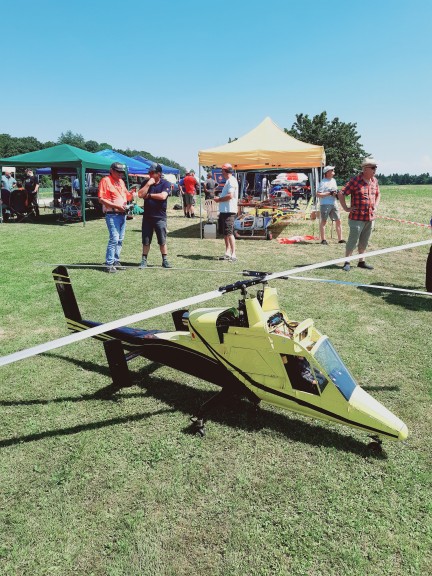
New RC helicopter for 2023/2024
Four new and unusual RC helicopters with Flettner double rotors are planned for 2023/2024. You can get more information about the models by clicking on the respective link or photo:
K-Max 1200, scale of 1 : 4.4, scale design, rotor diameter 2.8 m / 3.3 m, powered by PJW-Turbine PRO-6000 or electrically by Hacker Q-80
NC-2001 "Abeile", on a scale of 1 : 4.8, in scale design, rotor diameter 2.8 m, electric drive with Hacker Q-80 (other drive variants in preparation)
K-Max Trainer "Dragon", rotor diameter 2.5 m, driven by PJW turbine PRO-6000 or electrically by Hacker Q-80
Dragonfly T20-RC, rotor diameter 2.5 m, driven by PJW turbine PRO-6000 or electrically by Hacker Q-80
Manufacturing licenses for industrial helicopter drones
On request, we offer licenses for the production of various industrial helicopter drones. All helicopter drones have been developed by us over the past few years and are now for sale. You can find detailed information and prices for each type in our shop.
The performance data of the drones on offer is far above that of the usual drones, so flight times of up to 3.5 hours or the carrying of payloads of up to 50 kg are achieved (fuel including payload in the form of equipment such as camera systems, 3D Scanners, measuring devices or, for example, spray devices).
In addition to the industrial helicopter drone Koax X-252 with coaxial rotor, we also offer all drone systems of the Dragonfly series (Dragonfly T15, T20, M35, M35-Trainer and T50) with Flettner double rotor, as well as the Dragon-50 V2 from the Swissdrones AG on.
All helicopter drones offered are industrial versions that have been optimized for minimal maintenance and costs. Equipped with an autopilot, the drones can be used for a variety of tasks.
Talk to us and benefit from our know-how!
Please watch also the product presentation video on YouTube about the Dragonfly T50:
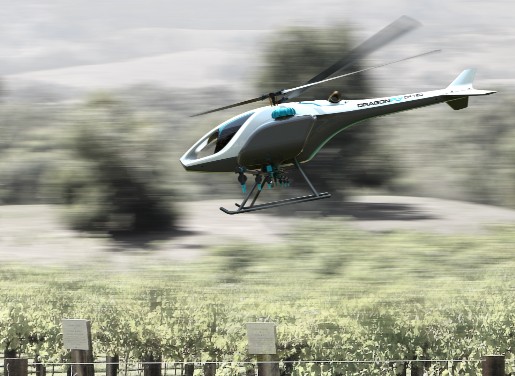
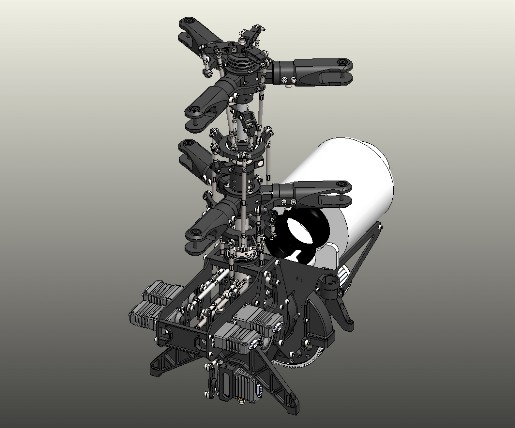
Project Kaman K-Max 1200
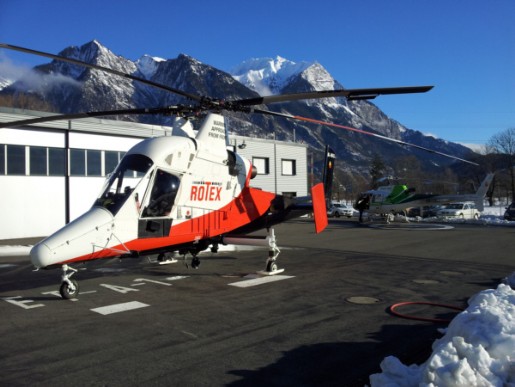
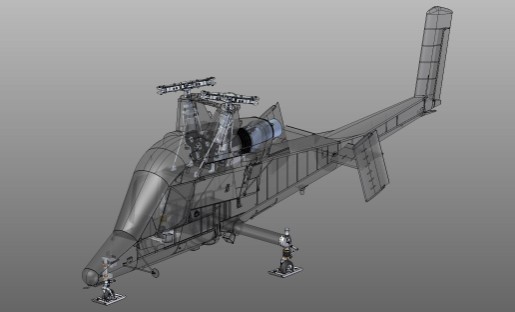
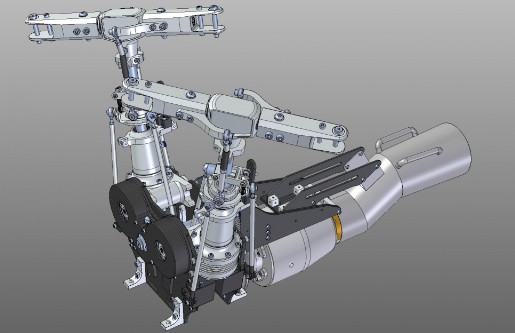
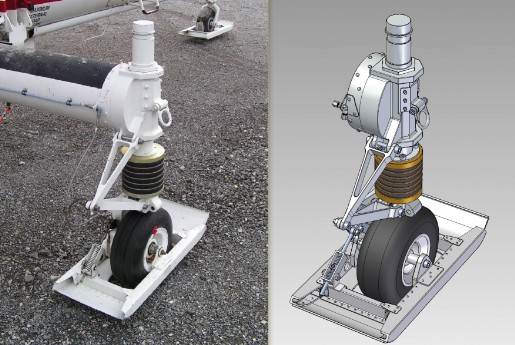
A few years ago we visited the Rotex company in Balzers (Liechtenstein). The Rotex company is currently operating the only two K-Max 1200s from the American company Kaman in Europe. According to Rotex, they have been using the two K-Max 1200s as cargo helicopters for many years with great success.
We met with Haller-3D on site to scan one of the two original helicopters with a 3D laser scanner and measure it with millimeter precision. The helicopter was scanned with a precision rotating laser within one morning. The result of this complex and not exactly cheap scan is an exact digital image of the helicopter. The data set is then post-processed and reduced to the scale of 1 : 4.5 of the K-Max 1200 model. The data set then serves as a template for milling the multi-part hull shapes for the model.
The multi-part hull molds are made in Uriol. The fuselage cell itself will consist of a GRP sandwich with CFRP reinforcements. The length of the K-Max 1200 model is approx. 2.9 m and consists of the middle part, the detachable rear and the front, large detachable hood. In addition, the tail units, frames, disc set, etc. The complex 3-leg landing gear is made entirely of aluminum and is also absolutely scale.
In addition to the well-known Flettner mechanics for the Jakadofsky Turbine PRO-6000, there will be a version for the JetCat SPT10 and also an electric version for the Hacker Q80.
More information can be found hier
NEW in program: the legendary "Oberursel URII" - 9-cylinder rotary engine, scale 1 : 3, displacement 560 cc
Superscale version on a scale of 1: 3. The exterior is exactly modeled on the original engine from 1917. Inside, however, designed with modern technology for durability and easy operation.
The engine was i.a. in the legendary Fokker Dr. I used. The Fokker Dr.I was a three-decker fighter aircraft produced by the Fokker Flugzeugwerke in Schwerin. The aircraft used by the German Army in the First World War from 1917 onwards became famous in particular through the most successful fighter pilot of the First World War, Manfred von Richthofen (the "Red Baron"), who scored 19 of his 80 aerial victories in fully or partially red-painted Fokker triplane and also died in a Dr.I.
Scope of construction plan:
133 pages, DIN A4, plastic binders, alongside some images from the 3D CAD
Technical data:
• Oberursel URII, 9-cylinder rotary engine
• Displacement: approx. 560 cm³ (9 x approx. 62ccm)
• Bore: 37.3 mm
• Stroke: 54 mm
• Weight: approx. 8.5 kg
• Speed: 1,200 - 3,000 rpm
• Propeller: 40 x 12 inches (= 102 cm x 30.5 cm)
• Power: approx. 4.5 hp
• Length: approx. 445 mm (up to propeller driver)
• Total length: approx. 510 mm
• Outside diameter: approx. 360 mm
Technical design:
• Operation as a petrol engine with high voltage ignition system and Walbro carburettor
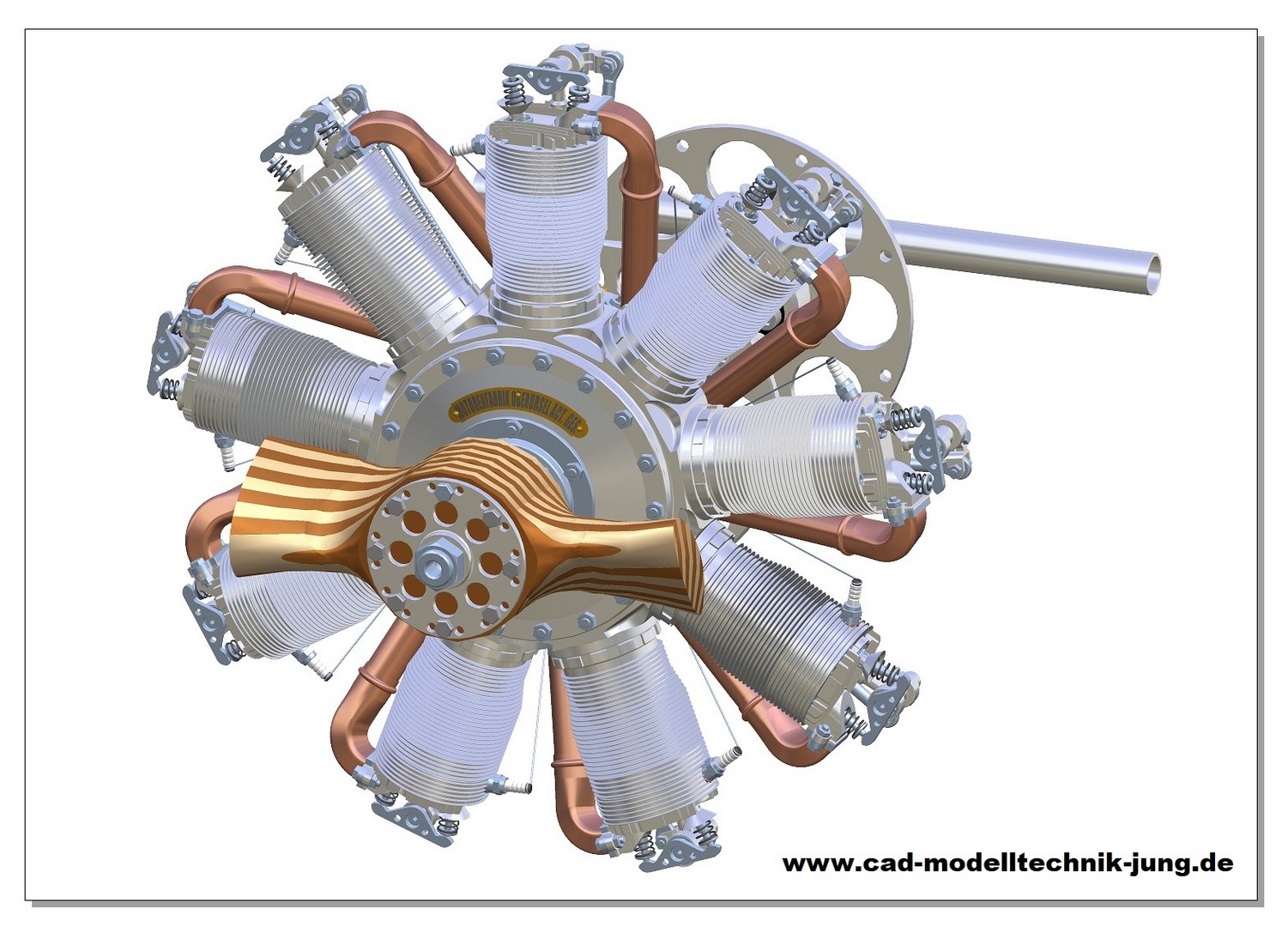
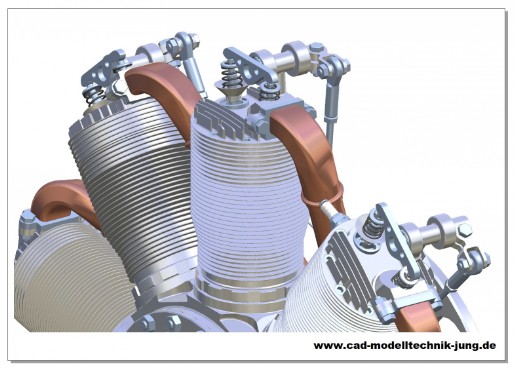
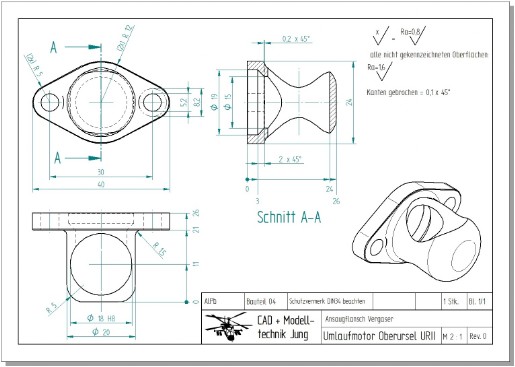
NEW in program: the legendary : the legendary ANZANI W3 engine
Superscale version on a scale of 1: 3. The exterior is exactly modeled on the original engine from 1909. Inside, however, designed with modern technology for durability and easy operation.
With the Blériot XI, equipped with the Anzani W3 engine, Louis Blériot flew over the English Channel in 1909, thus establishing modern aviation.
Alessandro Anzani was an Italian engineer and racing driver and developed a variety of different engines to drive motorcycles, cars and airplanes (born December 5, 1877 in Milan, † July 24, 1956 in Merville-Franceville-Plage).
Scope of construction plan:
102 pages, DIN A4, plastic binders, alongside some images from the 3D CAD
Technical data:
• ANZANI W3 engine, 3-cylinder half-star engine
• Displacement: approx. 120 cm³ (3 x approx. 40 ccm)
• Bore: 35 mm
• Stroke: 40 mm / 42.4 mm
• Weight: approx. 3.2 kg
• Speed: 1,500 - 4,000 rpm
• Propeller: 32 x 12 inches (= 81.3 cm x 30.5 cm)
• Power: approx. 2.5 HP
• Length: 209 mm (to propeller driver)
• Total length: 263 mm
• Width: 312 mm (over all)
• Height: 238 mm
Technical design:
• Like the original, as a long stroke, designed for high torque and low speed
• Split crankshaft, four roller bearings (3 x ball bearings, 1 x needle bearing)
• 3 camshafts, each with double ball bearings, driven by a gear drive
• Needle bearing main connecting rod (optimized with regard to kinematics)
• One vertical exhaust valve per cylinder
• A hanging inlet valve per cylinder (designed as a so-called sniffer valve as in the original)
• Operation as a glow igniter or as a petrol engine equipped with a high-voltage ignition system and Walbro carburettor
• Construction plan available now
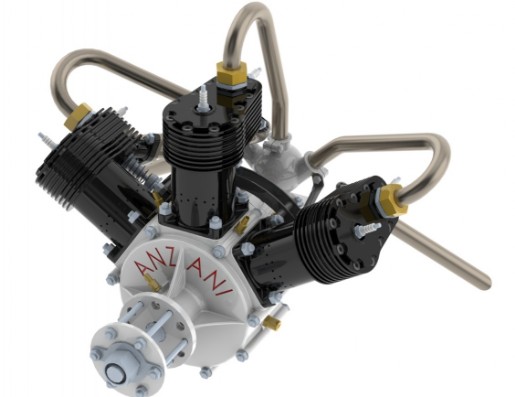
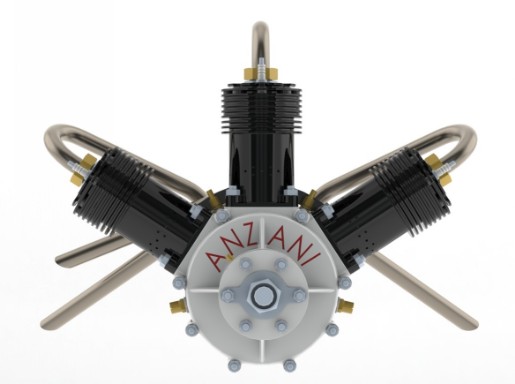
5-blade main rotor head for Airbus H145
The CAD design for the new 5-blade main rotor head of an Airbus H145 (formerly EC145) is currently being commissioned. The rotor head is designed for a rotor diameter of 3.4 m and is modeled as exactly as possible on the original. As a special feature, the rotor head is equipped with integrated, rubber-mounted flapping / swivel joints. The rotor head is designed for a rotor shaft diameter of 20 mm. A modified version of our PRO-X mechanism is used as the turbine mechanism. This is installed as a compact suspension mechanism in the rotor dome.
The associated model of the Airbus H145 has been available from Premium Helicopter for some time and will soon be offered with the new rotor head. You can find out more about this extraordinary large model at: https://www.premium-helicopter.de
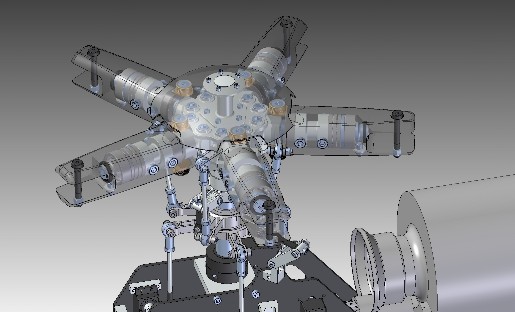
Rotorkopf Aérospatiale SA-315 Alouette II "Lama"
The construction of a rotor head for an Aérospatiale SA-315, better known to many under the name Alouette II "Lama", was commissioned at the end of 2016. The special thing about it? ... the downright gigantic scale of 1: 2.5. The specification was also to reproduce the original of the rotor head as true to scale as possible in all details and at the same time enable neutral flight behavior. If you look at the pictures from the 3D CAD construction, you can only say that we should have succeeded more than we did.
In the meantime, the model of the Aérospatiale SA-315 Lama by Robert Illmaier has been completed and has already been impressively presented on various flight days. Some photos, a YouTube video and some additional information about this absolutely perfect large model can be found in our gallery. We can only say congratulations for this globally unique large model of the "Lama".
Design features of rotor head Aérospatiale SA-315 Alouette II "Lama"
Scale: 1: 2.5
Pitch circle diameter: 825 mm
Rotor shaft diameter: 30 mm (or 20 mm with reducing sleeve)
Blade bearing shaft diameter: 20 mm
Weight: approx. 8.5 kg
Blade grip: 22 mm
Blade hole: 6 mm
Execution: Scale
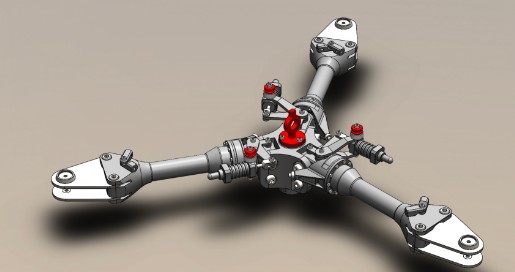
4 blade tail rotor for Bell 429
The CAD construction for the 4-blade tail rotor of the model replica of the Bell 429 is currently being commissioned. The 4-blade tail rotor is designed as a 2 x 2-blade tail rotor, like the original. Both levels are arranged at an angle of 55 degrees to each other and run on offset levels next to each other. The two 2-blade tail rotors are pendulously suspended on the tail rotor shaft. The blade holders are each equipped with 2 radial bearings and one axial bearing.
In the original, this considerable design effort is used to ensure that the tail rotor runs particularly quietly when the helicopter is in operation. In the model replica, it is more about the most true-to-life replica of the original.
The associated model of the Bell 429 is currently being produced by Premium Helicopter and will soon be available with a rotor diameter of approx. 2.5 m, also in absolute scale. You can find out more about this extraordinary large model at: https://www.premium-helicopter.de
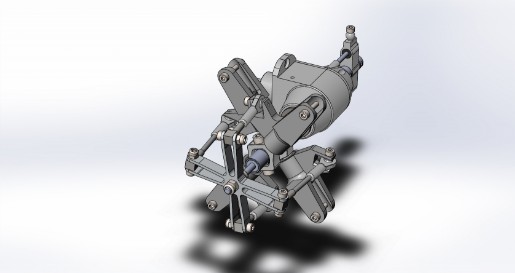
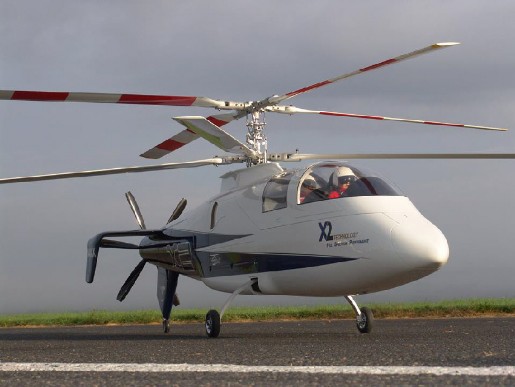
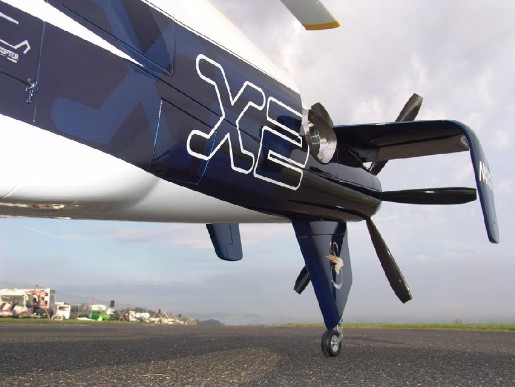
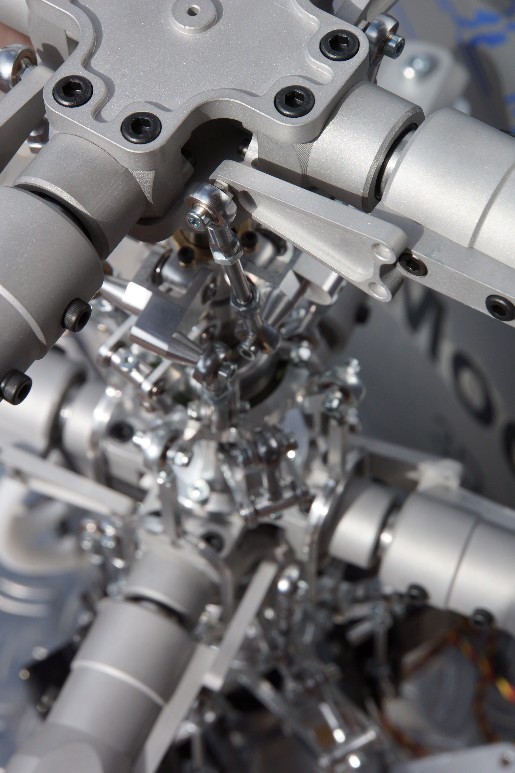
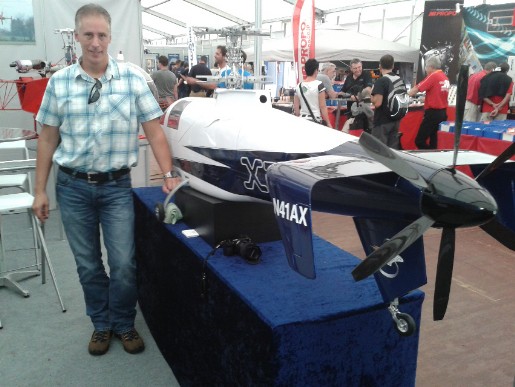
Sikorsky X2
The Sikorsky X2 is an experimental high-speed helicopter designed as a flight wrench by the US manufacturer Sikorsky Aircraft Corporation. It uses two counter-rotating coaxial rotors with extremely stiff blades and an additional pusher propeller at the rear, which enables the helicopter to reach speeds of up to 460 km/h.
On September 15, 2010, during a one-and-a-half-hour test flight near West Palm Beach, Florida, the X2 reached the development target speed of 250 knots (= 463 km/h) in level flight, making it 34 knots faster than the Westland Lynx, which held the top helicopter speed record at 216 knots (= 400 km/h) since 1984.
This goal of the X2 was already achieved after 17 test flights with a total duration of 16.5 hours. The X2 even reached a speed of 260 knots (481 km/h) when flying at a 2°-3° orbit inclination. This makes the Sikorsky X2 the fastest helicopter in the world.
The original Sikorsky X2 has a rotor diameter of 8.05 m. It is driven by an LHTEC T800-LHT-801 shaft turbine with an output of up to 1,340 kW.
The 1:3.3 scale model developed by Alterbaum Premium Helikopter was presented for the first time at the 2014 Jetpower trade fair in Bad-Neuenahr. The rotor diameter is 2.5 m. When designing the helicopter, great importance was attached to absolute faithfulness to the original. This can be seen, for example, in the lines of the fuselage cell with the tail units and the tail wheel, the paintwork, the retractable landing gear, the fully developed scale cockpit and the 6-blade pusher propeller and of course the two counter-rotating 4-blade rotors.
A heavily modified CRM-T mechanism from "CAD-Modelltechnik Jung" is used as the drive mechanism (designation CRM-X2). It is driven by the Jakadofsky Pro-X turbine, with an output of approx. 10 kW.
The large 6-blade pusher propeller at the rear of the model is designed as a controllable pitch propeller (diameter approx. 62 cm), just like the original. This is powered by a Plettenberg "Predator" electric motor. For reasons of center of gravity, this is arranged at the front of the fuselage cell. The motor is driven to the pressure plate by means of a flexible shaft.
This absolutely extraordinary and unique model is manufactured and distributed by the company Alterbaum Premium Helicopter.
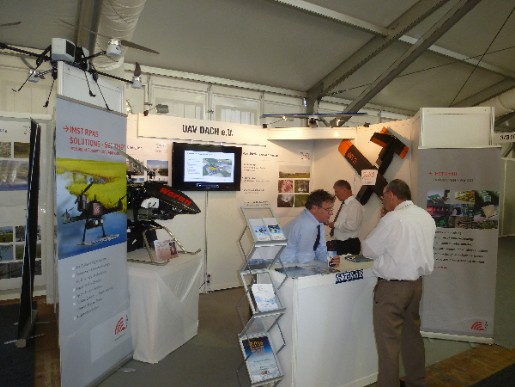
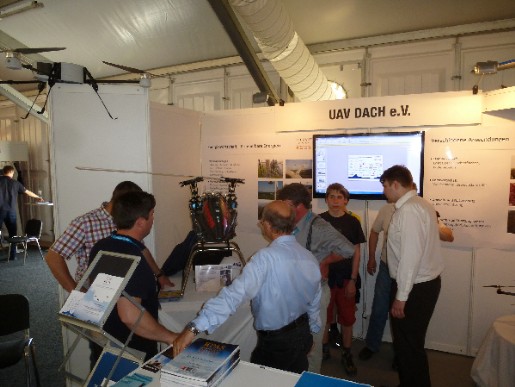
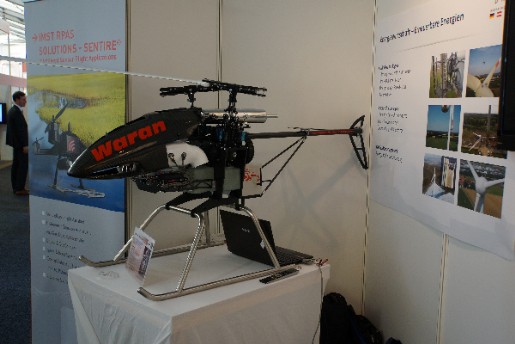
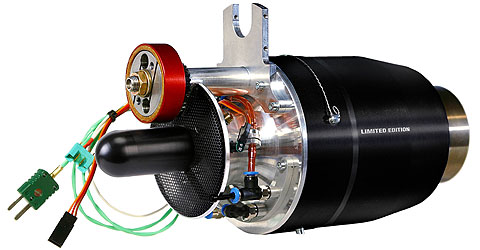
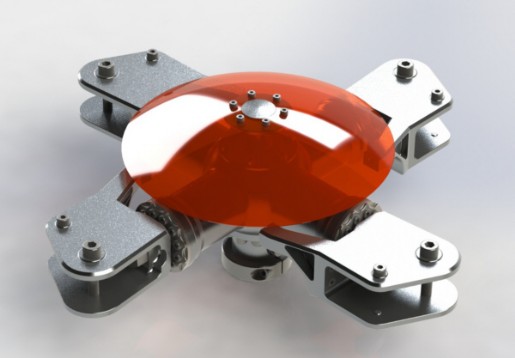
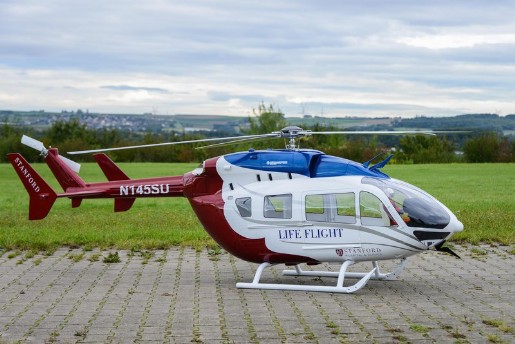
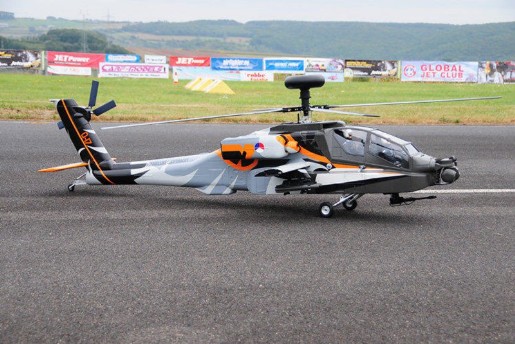
UAS-Hubschrauber "WARAN" oft the internationa fair ILA 2014, Berlin
As a member of the UAV-DACH Association, we had the opportunity to present the UAS helicopter "Waran" developed by us at the ILA-2014 in Berlin (May 20 to 25). Attached are some photos of the UAV-DACH booth with the "Waran" on display.
All photos courtesy of Herr von Bothmer, Chairman of UAV-DACH. Thanks very much! Also to Mr. Northman/Fa. Airbus Defense & Space
PRO-6000 Wellenleistungsturbine der Fa. Jakadofsky
Die PRO-6000 bieten wir ab sofort in unserem Shop an.
4-Blatt-Hauptrotorkopf für EC145
Als Auftragsarbeit entsteht zur Zeit die CAD-Konstruktion für den 4-Blatt-Hauptrotorkopf einer EC145. Der Rotorkopf ist für einen Rotordurchmesser von 3,37 m ausgelegt und ist dem Original exakt nachempunden. Als Besonderheit ist der Rotorkopf mit integrierten, gummigelagerten Schlaggelenken ausgerüstet. Der Rotorkopf ist für einen Rotorwellendurchmesser von 20 mm vorgesehen. Als Turbinenmechanik wird eine modifizierte Version unserer Python PRO-X Mechanik verwendet. Diese wird als kompakte Hängemechanik im Rotordom montiert.
Das zugehörige Modell der EC145 entsteht zur Zeit bei der Fa. Premium Helicopter und wird demnächst mit einem Rotordurchmesser von ca. 3,37 m im Maßstab 1 : 3,24 ebenfalls absolut Scale angeboten. Mehr zu diesem außergewöhnlichen Großmodell finden Sie unter: https://www.premium-helicopter.de
Konstruktion der mechanischen Komponenten für die Hughes AH-64 "Apache"
Als Auftragsarbeit entsteht zur Zeit die 3D-Konstruktion für alle mechanischen Komponenten für die Hughes AH-64 "Apache". Neben der Ausführung des komplexen Heckrotors fällt darunter das 3-Bein-Fahrwerk, bestehend aus den beiden Fahrwerksbeinen und dem Hecksporn. Außerdem das Abgassystem und der Visierdom, montiert oberhalb des Hauptrotors. Der Heckrotor ist im Original des manntragenden Hubschraubers wie beschrieben, recht komplex ausgeführt, um eine efektive Lärmminderung zu gewährleisten. Diese Konstruktion im Modell einer "Apache" umzusetzen, ist dabei ebenfalls nicht ganz einfach.
"CAD-Modelltechnik Jung" hat sich dieser Ausgabe gestellt und hat den Heckrotor und auch alle anderen genannten Komponenten im Modell möglichst Scale nachempfunden. Der Heckrotor ist wie im Original mit zwei versetzten, parallel angeordneten Heckrotor-Ebenen ausgestattet. Die beiden Rotoren haben dabei wie das Original ein Winkelversatz von 55°.
Das zugehörige Modell der Apache entsteht zur Zeit bei der Fa. Premium Helicopter und wird mit einem Rotordurchmesser von 2,5 m ebenfalls absolut Scale angeboten. Das Modell wird mit unserer Python-Turbinenmechanik SRM-T in Verbindung mit einer PRO-6000 Turbine angeboten.
Mehr zu diesem außergewöhnlichen Großmodell der Hughes AH-64 "Apache" finden Sie unter: https://www.premium-helicopter.de
Auch in unserer Galerie finden Sie mehr zu diesem außergewöhnlichen Modell.
Als Aufttragsarbeit für die Firma Alterbaum Premium-Helicopter wird zur Zeit an der Optimierung des bestehenden Fenestron der RAH-66 Comanche mit einem Rotordurchmesser von 2,5 m gearbeitet. Die vorhandene Konstruktion ist zwar konstruktiv in weiten Teilen gut ausgeführt, die Ansteuerung ist jedoch zu wenig präzise und hackelig. Für den extem wichtigen Teil, wie den hochdrehenden Fenestron der Comanche mit einem Abfluggewicht von fast 25 kg ist das leider nicht gut genug. CAD+Modelltechnik Jung hat deshalb die komplette Ansteuerung überarbeitet und auch für den Einsatz für Modelle über 25 kg eine Nachrechnung der mechan. Komponenten durchgeführt. Das ist Vorraussetzung für eine Musterabnahme des Modells beim DMFV oder DaeC.
Das Modell ist, wie immer bei Alterbaum Premium-Helicopter, in absoluter Perfektion gefertigt und mit den Mechanik-Komponenten aus der Feder von "CAD+Modelltechnik Jung", wie z. B. die SRM-T "Python" Mechanik und der von uns stark modifizierten, originalgetreuen Nachbildung des Fenestrons ausgeführt. Der 5-Blatt-Rotorkopf stammt ebenfalls aus unserem Hause.
Ein Video zu diesem außergwöhnlichen Modell finden Sie in unserer Galerie.
RAH-66 Comanche
Technische Daten:
- Maßstab: 1 : 5,5
- Rotordurchmesser: 2,5 m
- Rumpflänge: 2,8 m
- Gewicht: 22,5 kg
- Durchmesser Fenestron: 338 mm
- Anzahl Fenestron-Blätter: 10 Stk.
- Turbine: Jakadofsky Pro-6000, mit 6 kW Leistung
- Mechanik: SRM-T (kann alternativ auch mit der Elektromechanik SRM-A ausgerüstet werden)
- Rotorblätter: Alterbaum-Premium-Helicopter
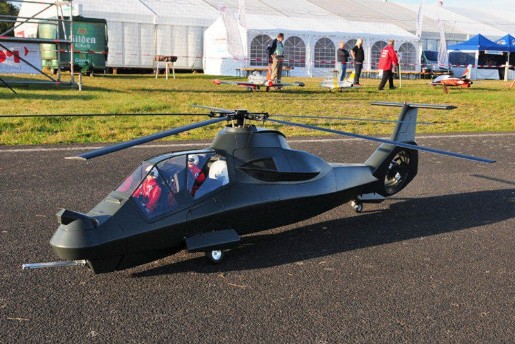
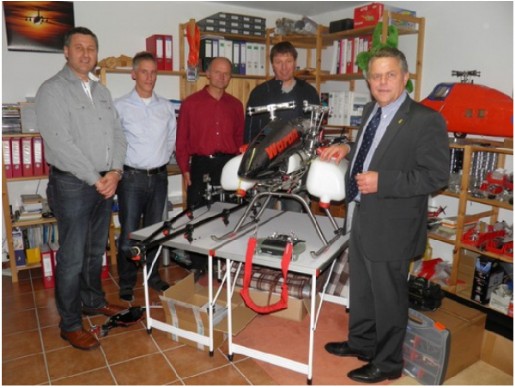
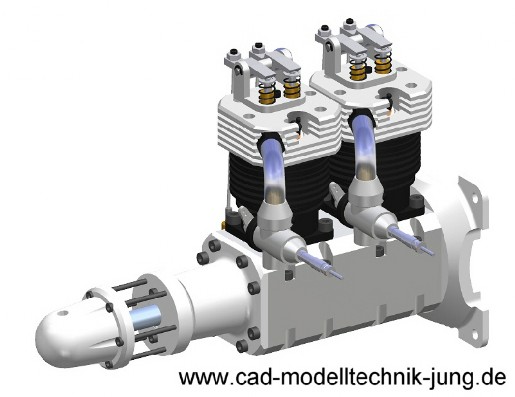
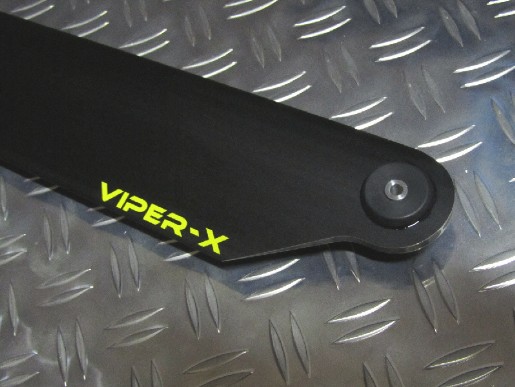
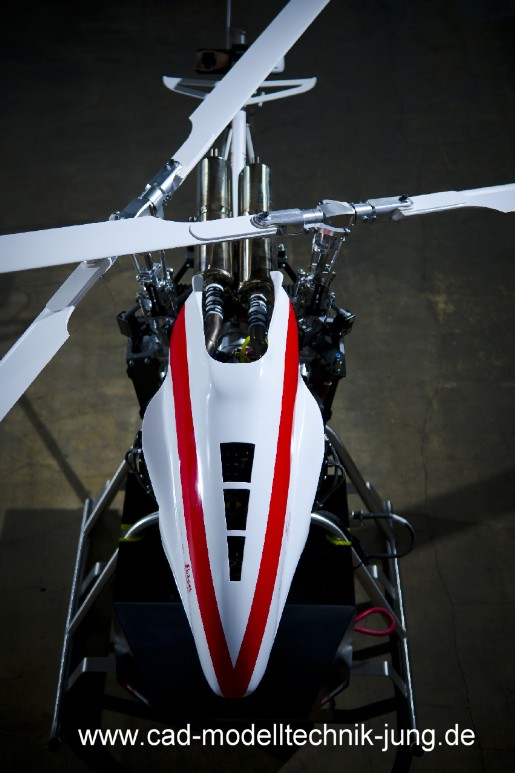
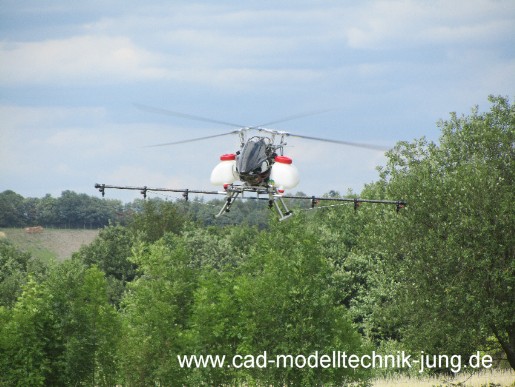
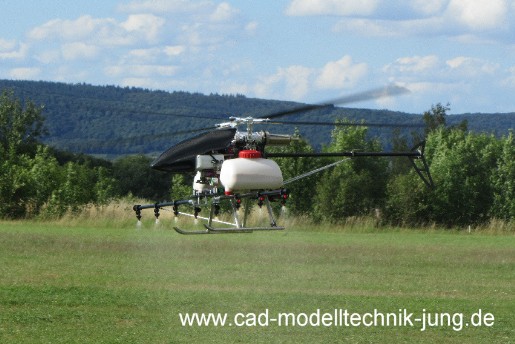
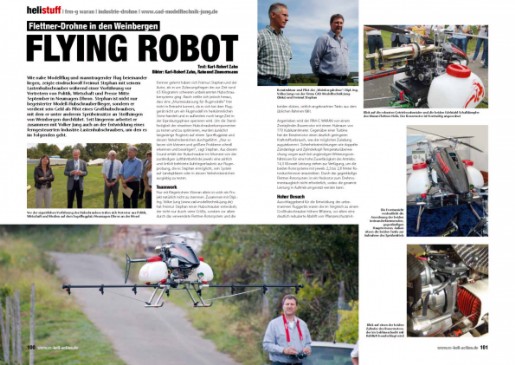
Hoher Besuch bei CAD+Modellechnik Jung:
Bereits im November 2011 hatten wir hohen Besuch in unserem Unternehmen: neben Herrn MdB Klaus-Peter Willsch waren die Herren Dr. Manfred Stoll (Fachgebietsleiter Weinbau der Forschungsanstalt Geisenheim) und Herr Dr. Robert Lönarz (Vizepräsident des Deutschen Oenologenverbandes) anwesend um sich einen Eindruck über unserer Entwicklung der sogen. "Weinbergsdrohne", im Einsatz als Pflanzenschutzgerät im Steillagenweinbau zu verschaffen.
Den gesamten Wortlaut des Artikels finden Sie auf der Webseite von Herrn MdB Klaus-Peter Willsch unter folgendem Link: Weinbergsdrohne als Helfer im Steillagenweinbau
Bauplan 2-Zylinder-Reihenmotor
Neu in unserem Bauplanprogramm ist der Bauplan eines 2-Zylinder-Reihenmotors. Der Motor verfügt einen Hubraum von 62 ccm. Die Kurbelwelle ist um 180° gekröpft ausgeführt, kann alternativ aber auch mit einem Kurbelzapfenversatz von 360° aufgebaut werden, als sogen. Parallel-Twin. Dadurch ergeben sich unterschiedliche Zündfolgen des Motors. Der Motor verfügt über eine untenliegene Nockenwelle und über Kipphebel gesteuerte Ventile.
Der Bauplan verfügt über 60 Seiten, DIN-A4 Ausdrucke und ein farbiges Deckblatt. Wie immer ist neben der Baubeschreibung und einer ausführlichen Stückliste, auch ein Lieferantennachweis enthalten. Jedes Bauteil ist auf einem Blatt (komplizierte Teile auch auf mehreren Blättern) normgerecht vermasst und in mehreren Ansichten und Schnitten dargestellt. Eine Isometrische Darstellung ergänzt jede Zeichnung. Neben den Einzelteilzeichnungen vereinfachen Baugruppen- und Schnittzeichnungen des kompletten Motor den Aufbau. Damit sollte ein möglichst einfaches Nachbauen des Motors garantiert sein. Der Bauplan wird ab sofort in unserem Shop zu einem Preis von 29,80 Eur zzgl. Porto/Verpackung angeboten.
Diverse Videos der nach unseren Bauplänen erbauten Motore finden Sie in unsere Galerie.
- VIPER-X 76 Aluminum-Hauptrotorblätter
- Darauf haben weltweit viele Piloten von großen Trainer- und Scale-Hubschraubern gewartet:
- VIPER-X 76 Aluminum-Hauptrotorblätter für 2-Blatt-Rotorköpfe oder Mehrblatt-Rotorsysteme
- für Trainer- oder Scale-Hubschrauber
- Blattlänge bis 1.175 mm (exakte Länge bei Bestellung angeben)
- S-Schlag Profil
- 76 mm tief
- 14 mm Blattanschluß
- 4 mm, 5 mm oder 6 mm Blattanschlußbohrung (bei Bestellung angeben)
- schwarz eloxiert
- links oder rechts laufend (bei Bestellung angeben)
- Lieferzeit 1 - 2 Wochen
Mehr Informationen und die Preise finden Sie in unserem Shop
Die Hauptrotoblätter VIPER-X sind ab sofort verfügbar. Bestellungen bitte über unseren Shop ausführen. Die neuen Hauptrotoblätter wurden ausgestellt auf der Messe "ROTOR-LIVE" am 12./13. März in Iffezheim.
Hubschrauber-Drohne "WARAN"
Für die industrielle Anwendung von Hubschrauber-Drohnen (UAV) arbeiten wir zur Zeit an dem wesentlich vergrößerten Flettner-Hubschrauber FRM-G "Waran".
Als Antrieb dient ein Benzinmotor mit einer Leistung von ca. 20 PS. Der Hubschrauber hat einen Rotordurchmesser von 2,8 m.
Der Hubschrauber wiegt trocken ca. 40 kg. Das derzeitige maximale Abfluggewicht liegt bei 75 kg. D.h. der Hubschrauber verfügt über eine Zuladung von bis zu 35 kg.
Die Verwendung des Benzinmotors hat den Vorteil des wesentlich geringeren Krafstoffverbrauchs gegenüber einer Turbine. Die Verwendung eines Boxermotors sorgt für vibrationsarmen Lauf des Motors. Der Motor ist mit einem On-Board-Starter für ein einfaches Starten des Motors versehen. Für die Stromverbraucher an Bord und für evtl. zusätzliche Stromverbraucher der Payload wird zukünftig ein Generatorsystem mit integriert.
Der Flettner-Doppelrotor besitzt zwei gegenläufige Rotoren und benötigt deshalb keinen Heckrotor zum Drehmomentausgleich. Dadurch steht eine Mehrleistung von bis zu 15% gegenüber einem konventionellen Hubschrauber zur Verfügung. Der Hubschrauber kann diese Mehrleistung in Form von höherer Hubleistung voll ausnutzen. Dieser Hubschraubertyp kann dadurch mehr als das eigene Gewicht an Zusatzgewicht heben.
Als Antrieb dient ein Benzinmotor mit einer Leistung von ca. 20 PS. Der Hubschrauber hat einen Rotordurchmesser von 2,8 m.
Der Hubschrauber wiegt trocken ca. 40 kg. Das derzeitige maximale Abfluggewicht liegt bei 75 kg. D.h. der Hubschrauber verfügt über eine Zuladung von bis zu 35 kg.
Die Verwendung des Benzinmotors hat den Vorteil des wesentlich geringeren Krafstoffverbrauchs gegenüber einer Turbine. Die Verwendung eines Boxermotors sorgt für vibrationsarmen Lauf des Motors. Der Motor ist mit einem On-Board-Starter für ein einfaches Starten des Motors versehen. Für die Stromverbraucher an Bord und für evtl. zusätzliche Stromverbraucher der Payload wird zukünftig ein Generatorsystem mit integriert.
Der Flettner-Doppelrotor besitzt zwei gegenläufige Rotoren und benötigt deshalb keinen Heckrotor zum Drehmomentausgleich. Dadurch steht eine Mehrleistung von bis zu 15% gegenüber einem konventionellen Hubschrauber zur Verfügung. Der Hubschrauber kann diese Mehrleistung in Form von höherer Hubleistung voll ausnutzen. Dieser Hubschraubertyp kann dadurch mehr als das eigene Gewicht an Zusatzgewicht heben.
Die Hubschrauber-Drohne kann für alle Aufgaben verwendet werden, bei denen es auf möglichst lange Flugzeiten bzw. auf eine maximale Nutzlast ankommt. Das können z.B. Meßgeräte für Überwachungsflüge sein oder wie dargestellt eine Sprühanlage für die Ausbringung von Pflanzenschutzmitteln.
Von der Konstruktion hat dieser Flettner-Hubschrauber nichts mit dem kleineren Flettner-Hubschrauber FRM-T "Dragon" mit Turbinenantrieb zu tun. Alle Komponenten sind bei dem Typ FRM-G "Waran" auf die wesentlich höhere Leistung, die höhere Abflugmasse und die wesentlich längerne Flugzeiten und Wartungsintervalle ausgelegt.
Besonderen Dank für den Bericht geht an Herrn Karl-Robert Zahn und an Herrn Raimund Zimmermann. Anbei der Bericht aus der Fachzeitung "RC-Heli-Action", Ausgabe Dez. 2011:
Bericht_RC-Heli-Action
Von der Konstruktion hat dieser Flettner-Hubschrauber nichts mit dem kleineren Flettner-Hubschrauber FRM-T "Dragon" mit Turbinenantrieb zu tun. Alle Komponenten sind bei dem Typ FRM-G "Waran" auf die wesentlich höhere Leistung, die höhere Abflugmasse und die wesentlich längerne Flugzeiten und Wartungsintervalle ausgelegt.
Besonderen Dank für den Bericht geht an Herrn Karl-Robert Zahn und an Herrn Raimund Zimmermann. Anbei der Bericht aus der Fachzeitung "RC-Heli-Action", Ausgabe Dez. 2011:
Bericht_RC-Heli-Action
Anbei zwei Videos, aufgenomen bei Testflügen auf einem Sportflugplatz und in einem Weinberg (Flachlage) in Neumagen an der Mosel:
Anbei das Video der Präsentation der Flettner-Hubschrauber-Drohne in Neumagen/Mosel welches im SWR-Fernsehen (SWR Landesschau aktuell, Rheinland-Pfalz) ausgestrahlt worden ist:
Von der am 16.09.11 gegebenen Präsentation der Flettner-Hubschrauber-Drohne in Neumagen/Mosel ist außerdem ein Bericht in der Fachzeitung "RC-Heli-Action" erschienen.
Bauplan V8-Motors mit 165 ccm, inkl. angeflanschtem Untersetzungsgetriebe
Der bereits seit einigen Jahren angebotenen Bauplan des V8-Motors mit 132 ccm wird nun in einer zweiten Variante neu angeboten:
Als wichtigste Neuerungen sind das angeflanschte Untersetzungsgetriebe und der auf 165 ccm vergrößerte Hubraum zu nennen (entspricht 8 x 20,7 ccm Hubraum). Die äußeren Abmessungen des Motors bleiben dabei gleich, die Leistung steigt jedoch um ca. 30%. Die Ventilsteuerung ist nun in abgedichteten Nockenwellengehäusen untergebracht. Das Untersetzungsgetriebe verfügt über ein groß dimensioniertes Stirnzahnradgetriebe mit einer Untersetzung von 1 : 1,44). Das zusätzliche Untersetzungsgetriebe erlaubt dabei den Betrieb von vorbildgetreuen großen Mehrblattpropellern. Der Motor kann z.B. mit einem 30 Zoll großen 4-Blatt-Propeller betrieben werden (entsprechend ca. 76 cm Durchmesser). Damit normale (d.h. linkslaufende) Luftschrauben verwendet werden können, läuft der eigentliche Motor rechts herum. Durch das Stirnzahnradgetriebe läuft der Propeller dann wiederum links herum. Die großen Propeller sind Vorraussetzung für einen vorbildgetreuen Betrieb des Motors z.B. in Warbird`s wie der P51 Mustang. Die großen, langsam laufenderen Propeller besitzen einen besseren Wirkungsgrad. Das Modell kann dadurch auch ohne Schalldämpfer insgesamt leiser betrieben werden. Zusätzliche Änderungen betreffen die Kurbelwelle, welche eine komplette Neukonstruktion ist. Diese Änderung war erforderlich um die wesentlich höhere Leistung des Motors dauerhaft sicher zu übertragen.
Der Bauplan wird ab sofort in unserem Shop zu einem Preis von 39,80 Eur zzgl. Porto/Verpackung angeboten.
Ein Video des Motors im Betrieb finden Sie in unserer Galerie.
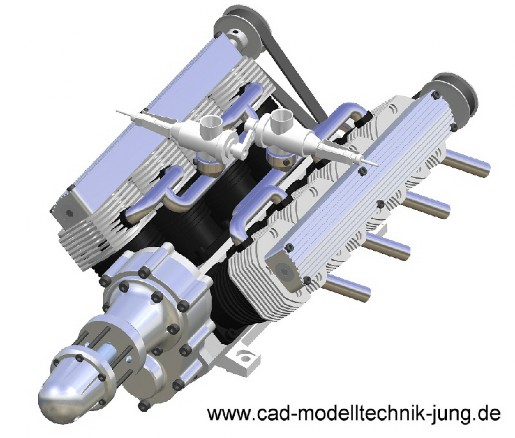
Turbinenmechanik SRM-T "Python", Version 3
Ab sofort verfügbar ist die neue Turbinenmechanik SRM-T "Python" in der Ausführung mit PJW-Turbine in der Anordnung hinter der Rotorwelle (Version "3"). Diese Ausführung eignet sich insbesondere für verschiedene Bell-Hubschrauber (z.B. Bell UH-1D, Bell 212 etc.). Die Mechanik mit einem Rotorwellendurchmesser von 15mm kann mit allen PJW Jakadofsky-Turbinen betrieben werden (z.B. Pro-Edition und Pro-5000). Die Mechanik eignet sich für Modell bis 2,5 m Rotordurchmesser. Mehr hierzu finden Sie unter der Übersicht Hubschrauber.
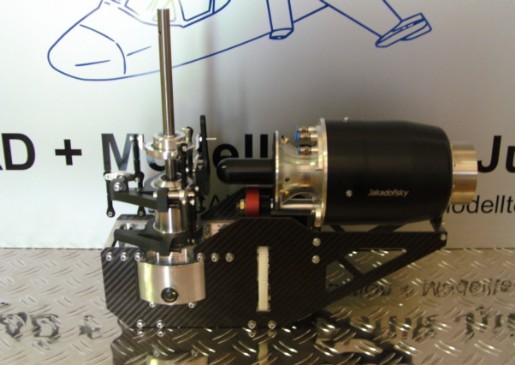
Um die größtmögliche Sicherheit des von uns angebotenen Koaxialrotor-Modellhubschraubers mit 2,0 - 2,4 m Rotordurchmesser zu gewährleisten, haben wir an der Fachhochschule Wiesbaden, Fachbereich Werkstoff und Bauteilprüfungen einen Zugversuch nach DIN EN 10002 durchführen lassen. Zur Information: bei einem Zugversuch werden die zu prüfenden Bauteile einer starken Zugkraft, bis zum Bauteilversagen durch Bruch unterworfen. Die dabei auftretenden Zugkräfte werden anhand eines Last-Weg-Diagramms aufgezeichnet.
Ziel war es die Bruchfestigkeit des Rotorkopfes mit seinen verschiedenen Bauteilen zu überprüfen. Hierzu wurde der Rotorkopf, bestehend aus Rotorzentralstück, Blatthalter und Rotorblatt (Fabrikat M-Blade, S75) mehrerer unterschiedlicher Tests unterworfen. Zur Ermittlung von Bauteilstreuungen wurden außerdem Tests mit gleicher Konfiguration mehrfach wiederholt.
Abschließend kann gesagt werden, daß die im Modellhubschrauber auftretenden Belastungen am Rotorkopf mit einer mehrfachen Sicherheit (> 3) abgedeckt werden. Die Bauteilstreuung ist dabei vernachlässigbar gering.
Die Bilder zeigen die Zugvorrichtung. Im Detail gut zu erkennen der Rotorkopf mit Blatthalter und Rotorblatt, sowie den am Bildschirm aufgezeichneten Kraftverlauf im Last-Weg-Diagramm.
